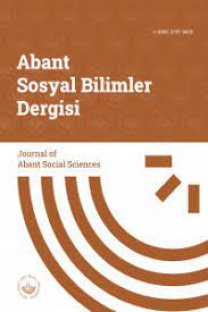İlkokuma Yazma Öğretiminde Çoklu Ortam Uygulamalarının Okuma Becerisi Üzerinde Etkililiği
Bu çalısmanın amacı, ilkögretim birinci sınıflarda Türkçe dersinde çoklu ortam araçlarının ilkokuma yazma ögretiminde etkililigini belirlemektir. Deneysel desenlerden “Kontrol Gruplu Son-Test Model” ile gerçeklestirilen bu arastırmada, Bolu İli Merkez İlkögretim okullarından Gazipasa İlkögretim Okulu 1-A sınıfı deney grubu, Canip Baysal İlkögretim Okulu 1- A sınıfı da kontrol grubu olarak belirlenmistir. Arastırmada ulasılan sonuçlar söyle özetlenebilir: Okumaya geçis zamanına iliskin deney grubunun puanlarının ( x =59,33) kontrol grubunun puanlarına ( x =80,22) göre daha olumlu oldugu; yani deney grubu ögrencilerinin okuma yazma becerisini anlamlı düzeyde daha kısa sürede kazandıkları sonucuna ulasılmıstır. Çoklu ortam uygulamalarının, birinci ve ikinci yarıyıl sonu sesli okuma hızlarında, deney grubu ile kontrol grubu arasında deney grubu lehine anlamlı bir fark yarattıgı yani deney grubu ögrencilerinin verilen metni daha kısa sürede okumalarına sebep oldugu tespit edilmistir.
Anahtar Kelimeler:
Çoklu ortam araçları ile ögretim, ilkokuma yazma, akademik basarı, çoklu ortam
-
The aim of study is to examine the effectiveness of multimedia applications in teaching Literacy Teaching at primary school at first year of primary school. Posttest control group design, as one of the experimental design of research studies, was used in the study. For the study Gazipasa Primary School and Canip Baysal Primary Schools located in the city center of Bolu was selected. 1-A class of Gazipasa Primary School was assigned as the experimental group and 1-A class of Canip Baysal Primary School was assigned as the control group of the study. The finding of the study indicated; It was found that the reading time mean scores ( x=59,33) of experimental group is more positive than the control group ( x =80,22). That is; the experimental group students learn writing and reading skills earlier than the control group students. A significant difference was found in favour of experimental group students in their first and second semesters reading aloud speed in which multimedia applications were used. That is; experimental group students read the text in a short time.
Keywords:
Teaching with multimedia instruments, Literacy teaching at primary school, multimedia, academic achie,
___
- Adams, M. J. (1990). Beginning to read: Thinking and learning Print Cambridge, MA:MIT Press.
- Akyol, Hayati ve Turan Temur. “Ses Temelli Cümle Yöntemi Ve Cümle Yöntemi İle Okuma Yazma Öğrenen Öğrencilerin Okuma Becerilerinin Öğretmen Görüşlerine Göre Değerlendirilmesi” Mustafa Kemal Üniversitesi Sosyal Bilimler Enstitüsü Dergisi 2008 . Cilt: 5. Sayı: 9. ss:6
- Alkan, M., Tekedere, H. ve Genç, Ö. (2003). İnteraktif Bilgi İletişim Teknolojilerinin Uzaktan Eğitimdeki Uygulamaları. Elektrik, Elektronik, Bilgisayar Mühendislikleri Eğitimi 2. Ulusal Sempozyumu ve Sergisi ODTÜ- KKM, 30 Nisan-2 Mayıs 2003, Ankara. Web Sitesi: “http://egitim.emo.org.tr/semp03/bildiriler/ bildiri_30.doc”.
- Christine, Ahmed. “PowerPoint Versus Traditional Overheads. Wehich is More Effective for Learning?”. Geographic Source, 143:5, 1999.
- Çelenk, Süleyman. İlkokuma Yama Öğretiminde Aşamalı Bireşim Tekniğinin Etkinliği.1993, Ankara, Doktora Tezi
- Fitzgerald, Fill ve Shananan, Timothy. “Reading and Writing Relations and Their Development.” Educational Psychologist, 35(1) 39-50,2000.
- Gambrell, L., B., Morrow, L., M., Pennington, C. (2000). Early Childhood and Elementary Literature-Based Instruction: Current Perspectives and Special Issues. Handbook of Reading Research. (3)
- Jones, D. M., Macken, W. J., & Nicholls, A. P. (2004). The phonological store of working memory: is it phonological and is it a store? “Journal of Experimental Psychology: Learning, Memory, and Cognition”, 30, 656-674.
- Karasar, Niyazi. Bilimsel Araştırma Yöntemi. Ankara: Sanem Matbaacılık, 1991.
- Mayer, E. Richard ve Roxana Moreno. “Lecture Notes In Computer Science; Proceedings of the Third International Conference on Visual Information and Information Systems.” Vol. 1614, No. 793 – 800. 1999.
- Mayer, E. Richard “Multımedia Aids to Problem-Solving Transfer” İnternational Journal of Educational Research. 31 (1999) 611-623. www. Elsevier.com/locate/ijedures.
- Orhan, H. G. (2007). Bilgisayar Destekli İlkokuma Yazma Öğretimine İlişkin Öğretmen Görüşlerinin İncelenmesi. 16-18 Mayıs 2007 1. Uluslararası Bilgisayar ve Öğretim Teknolojileri Sempozyumu. Çanakkale: Çanakkale 18 Mart Bektaş, Abdulbaki. “Ses Temelli Cümle Yöntemiyle Gerçekleştirilen İlk Okuma-Yazma Öğretiminin Değerlendirilmesi” Yayımlanmamış Yüksek Lisans Tezi, Adana: Çukurova Üniv., Sınıf Öğretmenliği Anabilim Dalı, 2007.
- Ruşen, Mustafa. Hızlı Okuma. Alfa Basın Yayın Dağıtım, İstanbul,1995
- Paivio, Allan. “Dual Codıng Theory And Educatıon.” University of Western OntarioDraft chapter for the conference on “Pathways to Literacy Achievement for High Poverty Children,” The University of Michigan School of Education, September 29-October 1, 2006.
- Schroedel Schulbuchverlag. Rahmenrichtlinien für Die Grundschule. Herausgegeben vom Niedersachsischen Kulusminister. Hannover, Deutsch.1984.
- Sherman, D., Kleiman, G., Peterson, K. (2004). Techonology and Teaching Children to Read. USA: Education Development Center Publications. http://www.neirtec.org/reading_report - 07.O9.2008
- Yayın Aralığı: 3
- Başlangıç: 2000
- Yayıncı: Abant İzzet Baysal Üniversitesi Sosyal Bilimler Enstitüsü
